2020 MERCEDES-BENZ E-CLASS CABRIOLET weight
[x] Cancel search: weightPage 47 of 546
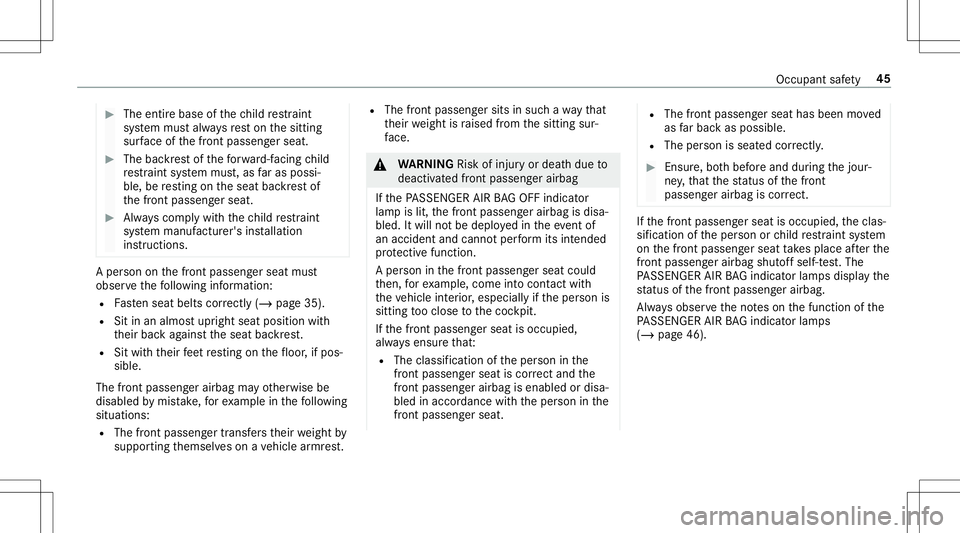
#
The entir ebase ofthech ild restra int
sy stem mus talw aysre st on thesitt ing
sur face ofthefront passeng erseat. #
The backres tof thefo rw ard-f acin gch ild
re stra int system mus t,as faras possi ‐
ble, beresting ontheseat backres tof
th efront passeng erseat. #
Alw ayscom plywit hth ech ild restra int
sy stem manuf acturer'sinstallation
ins truct ions . A
per son onthefront passeng erseat must
obser vethefo llo wing informatio n:
R Fasten seat belts correctl y(/ page 35).
R Sitinan almos tupr ight seatposi tion with
th eir bac kag ains tth eseat backres t.
R Sitwithth eir feet resting onthefloor ,if pos‐
sible.
The front passeng erairbag mayot her wise be
disabl edbymis take ,fo rex am ple inthefo llo wing
situat ions:
R The front passen gertr ansf ersth eir weight by
suppor tingthemselv eson ave hicle armr est. R
The front passeng ersits insuc hawa yth at
th eir weight israised from thesitt ing sur‐
fa ce. &
WARNIN GRisk ofinju ryor deat hdue to
deactiv ated front passeng erairbag
If th ePA SSENGER AIRBAGOF Find icat or
lam pis lit,th efront passeng erairbag isdisa‐
bled. Itwill notbe deplo yedin theeve ntof
an acci dent and canno tpe rfor m its intended
pr otect ive func tion.
A per son inthefront passeng erseat could
th en, forex am ple, com eint ocon tact with
th eve hicle interior ,especially ifth eper son is
sitt ing tooclose tothecoc kpit.
If th efront passeng erseat isoccupied,
alw aysensur eth at:
R The classificat ion oftheper son inthe
fr ont passeng ersea tis cor rect and the
fr ont passeng erairb agisenabl edordisa ‐
ble din accordance withth eper son inthe
fr ont passeng ersea t. R
The front passeng ersea thas been moved
as farbac kas possi ble.
R The person isseat edcor rectl y. #
Ensu re,bo th bef oreand during thejour‐
ne y,that thest atus ofthefront
passeng erairbag iscor rect. If
th efront passeng erseat isoccupied, theclas‐
sif ication oftheper son orchild restra int system
on thefront passeng erseat take splace afte rth e
fr ont passeng erairb agshut offself-t est.The
PA SSENGER AIRBAGind icat orlam psdispl aythe
st atus ofthefront passeng erairbag.
Alw aysobser vetheno teson thefunc tion ofthe
PA SSENGER AIRBAGind icat orlam ps
(/ page46). Oc
cupan tsaf ety 45
Page 53 of 546
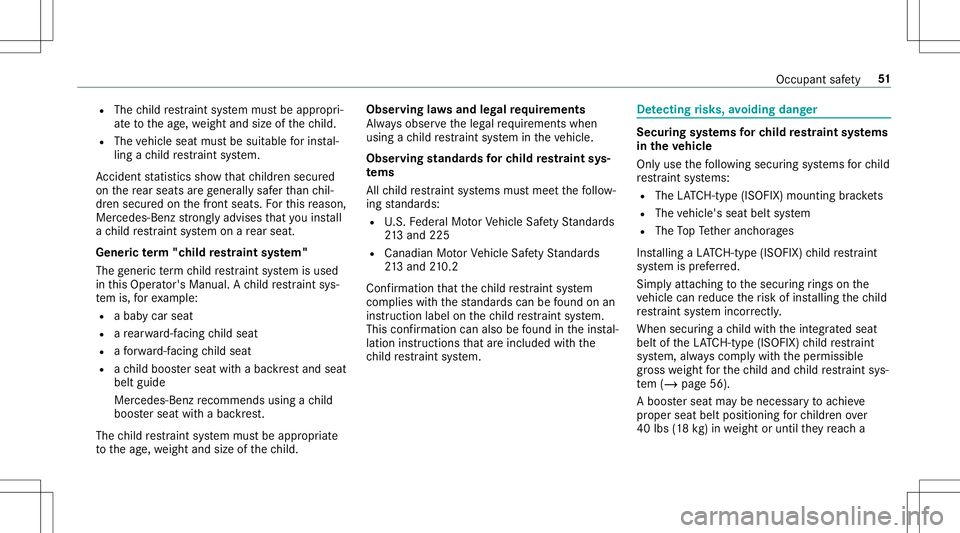
R
The child restra int system mus tbe appr opri‐
at eto theag e, we ight andsize ofthech ild.
R The vehicle seatmustbe suit able forins tal‐
ling ach ild restra int system.
Ac cid ent statis ticssho wthat childr ensecur ed
on there ar seat sar ege ner ally saf erthan chil‐
dr en secur edon thefront seats. Forth is reason ,
Mer cedes-Ben zst ro ng lyadvis esthat youins tall
a ch ild restra int system onare ar seat .
Gener icterm "child restra int system"
The gener icterm child restra int system isused
in this Opera tor's Manua l.A ch ild restra int sys‐
te m is, forex am ple:
R abab ycar seat
R are ar wa rd-faci ng child seat
R afo rw ard-f acin gch ild seat
R ach ild boos terseat withabac kres tand seat
belt guide
Mer cedes-Benz recomme ndsusing ach ild
boos terseat withabac kres t.
The child restra int system mus tbe appr opriate
to theag e, we ight andsize ofthech ild. Obser
vinglaws and legalrequ irement s
Alw aysobser vetheleg alrequ iremen tswhen
using ach ild restra int system intheve hicle.
Obser vingstandar dsforch ild restra int sys‐
te ms
All child restra int systems mustmee tth efo llo w‐
ing standar ds:
R U.S. Feder alMo torVe hicle SafetySt andar ds
21 3and 225
R Canadi anMo torVe hicle SafetySt andar ds
21 3and 210.2
Conf irmatio nth at thech ild restra int system
com plies withth est andar dscan befound onan
ins truct ion label onthech ild restra int system.
This confirm atio ncan also befound intheins tal‐
lation instruct ions that areinc luded withth e
ch ild restra int system. De
tectin grisk s,avo iding danger Secur
ingsystems forch ild restra int systems
in theve hicl e
Only usethefo llo wing secur ingsystems forch ild
re stra int systems:
R The LATC H-type (ISOFIX )mou nting brac kets
R The vehicle's seatbeltsystem
R The TopTe ther anc horages
Ins talling aLA TC H-type (ISOFIX )ch ild restra int
sy stem isprefer red.
Sim plyatt aching tothesecur ingrings onthe
ve hicle canreduce therisk ofins talling thech ild
re stra int system incor rectl y.
When securingach ild withth eint egr ated seat
belt oftheLA TC H-type (ISOFIX )ch ild restra int
sy stem, alwayscom plywithth eper missible
gr oss weight forth ech ild and child restra int sys‐
te m (/ page56).
A boos terseat maybe necessar yto achie ve
pr oper seatbeltposition ingforch ildr enove r
40 lbs (18 kg )in we ight orunt ilth ey reac ha Oc
cupan tsaf ety 51
Page 108 of 546

#
Alw aysbe par ticular lycareful whenin
th evicinit yof theta ilpipe andtailpipe
tr ims and super visechildr envery
clos elywhe nin this area. #
Beforean ycon tact, allo w thecar parts
to cool down. The
drivi ng charact eristic sof your vehicle are
dependent onthedis tribution oftheload within
th eve hicle. Yousho uld bear thefo llo wing in
min dwhen loading theve hicle:
R neverex ceed theper missible gross mass or
th egr oss axle weight rating forth eve hicle
(including occupants). Thevalues arespec i‐
fi ed on theve hicle identif ication plateon the
ve hicle's B-pillar.
R theload mustno tpr otru de abo vetheupper
edg eof theseat backres ts.
R alwaysplace theload behind unoccupied
seats ifpossible.
R secur eth eload using thetie-do wneyes and
dis tribut eth eload evenly. St
ow agespace sin theve hicl eint erior Ov
ervie wof thefront stowage com part‐
men ts 1
Stow agecom partment inthedoor s
2 Stow age/t eleph onecom partment inthe
ar mr estwit hmult imed iacon nections and
st ow agecom partment ,e.g. foran MP3
pla yer
3 Stow agecom partment inthefront cent er
con sole withaUSB port(depending onthe
ve hicle's equipment)
4 Glovebox Loc
king andunloc kingthegl ove box #
Turn themec hanical keya qu artertur ncloc k‐
wis e0048 (to loc k)or count er-cloc kwise 0047(to
unloc k). 10
6
Sea tsand stow ing
Page 387 of 546

*
NO
TEDama gedue totowing away at
exc essiv elyhigh speeds orove rlong dis‐
ta nces The
drivet ra in could bedamag edwhen tow‐
ing atexc essiv elyhigh speeds orover long
dis tances. #
Atowing speed of30 mph(50 km/h)
mus tno tbe exc eeded. #
Atowing distan ceof30 miles(50 km)
mus tno tbe exc eeded. &
WARNIN GRisk ofacci dent whento wing
a ve hicle whichis toohea vy
If th eve hicle being tow- star tedor towe d
aw ay ishea vier than theper missible gross
mass ofyour vehicle, thefo llo wing situat ions
can occur:
R The towing eyema ybecome detach ed.
R The vehicle/tr ailercombination may
sw erve oreve nov ertur n. #
Ifano ther vehicle istow- star tedor
to we daw ay,its weight mustno texc eed th
eper missible gross mass ofyour ow n
ve hicle. If
ave hicle mustbe tow- star tedor towe daw ay,
its per missib legross weight mustno texc eed the
per missible gross weight oftheto wing vehicle. #
Information ontheper missible gross mass of
th eve hicle canbefound ontheve hicle iden‐
tif ication plate(/ page426). #
Vehicl eswith automatic transmiss ion:Do
no topen thedr iver's door orfront passeng er
door ,ot her wise theaut omatic transmiss ion
aut omaticall yshif tsto position 005D. #
Installth eto wing eye(/ page38 7). #
Fasten theto w bar .
* NO
TEDama gedue toinc orrect connec‐
tion oftheto w bar #
Onlyconnect theto w rope ortow bar to
th eto wing eyes. #
Deact ivat eth eaut omatic locking mechanism
(/ page72 ). #
Donotactiv ateth eHOLD function. #
Deact ivat eAc tiveBr ak eAssi st(/ pag e17 6). #
Vehicl eswith automatic transmiss ion:
Shif tth eaut omatic transmiss iontoposition
005C. #
Release theelectr icpar king brak e. &
WARNIN GRisk ofacci dent dueto limi‐
te dsaf ety-re lat ed func tionsdur ing the
to wing proce ss
Saf ety-re lat ed func tionsar elimit edorno lon‐
ge rav ailable inthefo llo wing situat ions:
R theignition isswitc hedoff.
R thebr ak esy stem orpowe rst eer ing sys‐
te m ismalfu nctioning.
R theener gysupply ortheon- boar delectr i‐
cal system ismalfunct ioning.
When your vehicle isthen towe daw ay,signif ‐
icant lymor eef fort ma ybe requ ired tosteer
and brak eth an isno rm allyre qu ired. #
Use ato w bar . Br
eakdo wnassis tance 38
5
Page 403 of 546
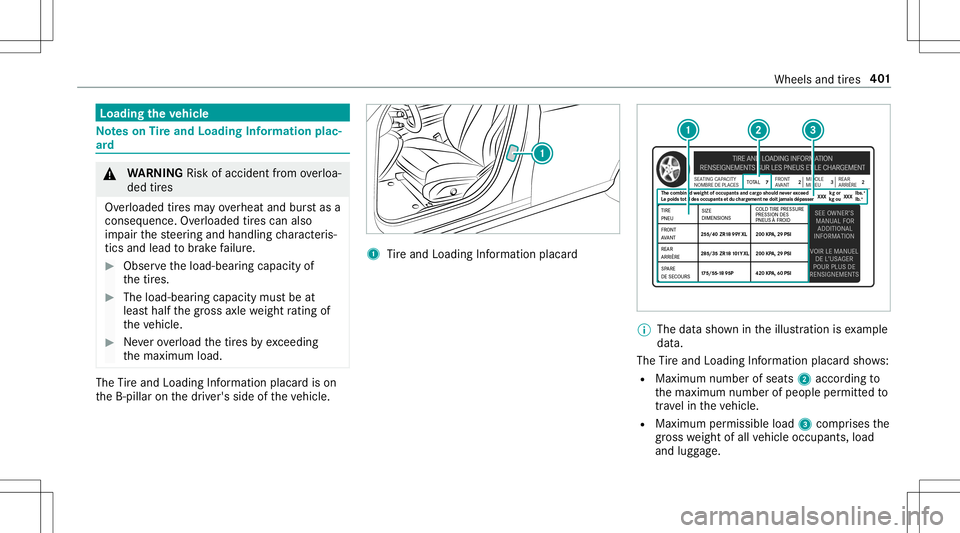
Load
ingtheve hicl e No
teson Tire and Loading Information plac‐
ar d &
WARNIN GRisk ofacci dent from overloa‐
ded tires
Ov erloaded tires ma yove rheat and burstas a
con sequenc e.Ov erloaded tires can also
im pair thesteer ing and handling charact eris‐
tic sand lead tobrak efa ilur e. #
Obser vetheload-bear ingcapacity of
th etir es. #
The load-bear ingcapacity mustbe at
leas thalf thegr oss axle weight rating of
th eve hicle. #
Neverove rload thetir es by exc eeding
th emaximum load. The
Tire and Loadi ngInfo rm atio nplacar dis on
th eB-pillar onthedr iver's side oftheve hicle. 1
Tire and Loadi ngInfo rm atio nplacar d %
The datasho wnintheillus tration isexam ple
dat a.
The Tire and Loadi ngInfo rm atio nplacar dsho ws:
R Maximum numberofseats 2accor dingto
th emaximum numberofpeople permitt edto
tr ave lin theve hicle.
R Maximum permissible load3com prises the
gr os swe ight ofall vehicle occupants, load
and luggage. Wheels
andtires 40
1
Page 404 of 546
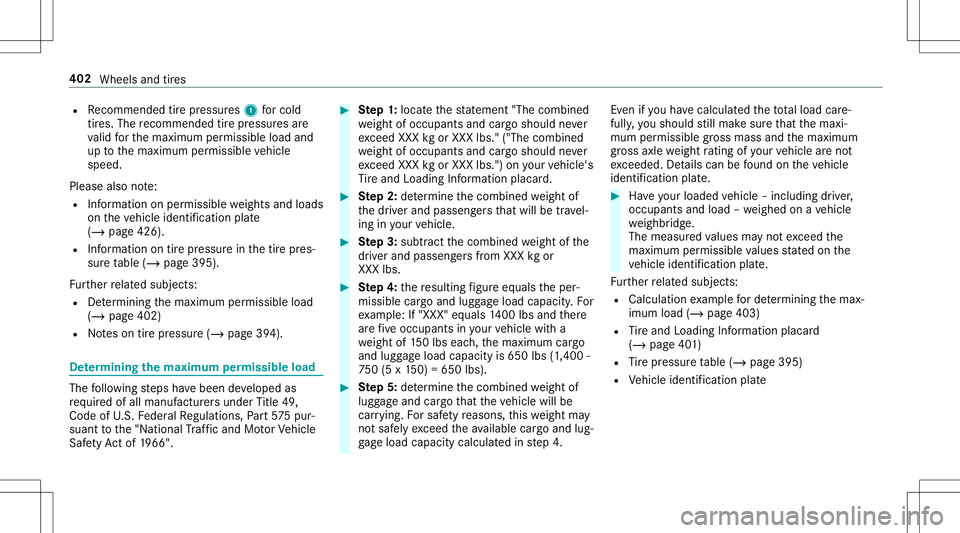
R
Recomme ndedtirepr ess ures 1 forcold
tir es. The recomme ndedtirepr ess ures are
va lid forth emaximum permissible loadand
up tothemaximum permissible vehicle
speed.
Please alsonote:
R Information onper missib lewe ight sand loads
on theve hicle identif ication plate
(/ page426).
R Information ontirepr essur ein thetir epr es‐
sur eta ble (/ page395).
Fu rther relat ed subje cts:
R Determ inin gth emaximum permissible load
(/ page402)
R Noteson tirepr essur e(/ page39 4). De
term ining thema xim um permis sible load The
follo wing steps have been developed as
re qu ired ofall manuf acturersunder Title 49,
Co de ofU.S. Feder alRe gulations, Part57 5pur‐
sua nttothe"N ational Traf fic and MotorVe hicle
Saf etyAc tof 1966". #
Ste p1: loca tethest at emen t"The combined
we ight ofocc upant sand cargoshould never
exc eed XXX kgorXXX lbs." ("The combined
we ight ofocc upant sand cargoshould never
exc eed XXX kgorXXX lbs.") onyour vehicle's
Ti re and Loadi ngInfo rm atio nplacar d. #
Ste p2: determ ine thecombin edweight of
th edr iver and passeng ersth at will betravel‐
ing inyour vehicle. #
Ste p3: subtr act thecombin edweight ofthe
dr iver and passeng ersfrom XXX kgor
XXX lbs. #
Ste p4: there sulting figur eeq uals theper‐
missible cargoand luggageload capacity .Fo r
ex am ple: If"XXX "eq uals 1400 lbs and ther e
ar efive occupant sin your vehicle witha
we ight of150lbs eac h,themaximum cargo
and luggageload capacity is650 lbs(1,400 -
75 0(5 x15 0) =650 lbs). #
Ste p5: determ ine thecombin edweight of
lugg ageand cargothat theve hicle willbe
car rying. Forsaf etyre ason s,this we ight may
no tsaf elyexc eed theav ailable cargoand lug‐
ga ge load capac itycalc ulatedinstep 4. Ev
en ifyo uha ve cal cul ated thetot alload care‐
full y,yo usho uld still mak esur eth at themaxi‐
mum permissible gross mass andthemaximum
gr oss axle weight rating ofyour vehicle areno t
exc eeded. Details can befound ontheve hicle
identif ication plate. #
Have your loaded vehicle –including driver ,
occupants andload –we ighed onave hicle
we ighbr idge.
The measur edvalues mayno texc eed the
maximu mper missi blevalues stat ed on the
ve hicle identif ication plate.
Fu rther relat ed subje cts:
R Calculation exam ple forde term inin gth emax‐
imum load(/page403)
R Tire and Loadi ngInfo rm atio nplacar d
(/ page40 1)
R Tire pressur eta ble (/ page395)
R Vehicle identif ication plate 402
Wheels andtires
Page 405 of 546
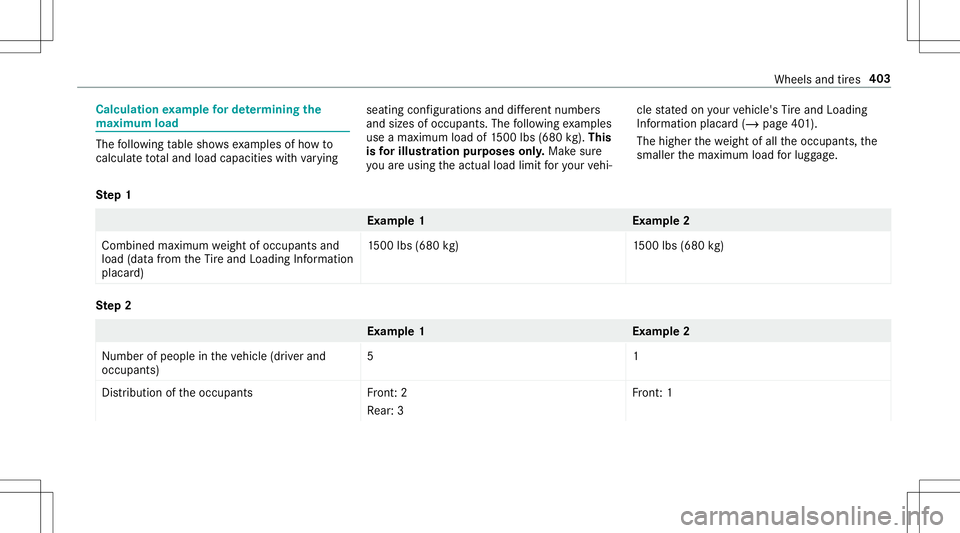
Calcu
lation exam ple forde term ining the
ma ximum load The
follo wing table showsexam ples ofhowto
cal cul ateto ta land load capac itieswithva rying seatin
gcon figur ations anddiffere nt num bers
and sizes ofocc upant s.The follo wing exam ples
use amax imum loadof1500 lbs (680 kg).This
is forillus tratio npur pos esonly.Mak esur e
yo uar eusin gth eactual loadlimit foryo ur vehi‐ cle
stat ed on your vehicle's Tire and Loadi ng
In fo rm atio nplacar d(/ page40 1).
The high erthewe ight ofall theoccupant s,the
smaller themaximum loadforlug gage .
Ste p1 Ex
am ple 1E xamp le2
Combine dmaxim umweight ofocc upant sand
load (datafrom theTire and Loadi ngInfo rm atio n
placar d) 15
00 lbs (680 kg)1 500lbs(680 kg) Ste
p2 Ex
am ple 1E xamp le2
Nu mb erofpeople intheve hicle (driver and
occupants) 51
Dis trib uti on oftheoccupant sF ront:2
Re ar:3 Fr
ont :1 Wheels
andtires 403
Page 406 of 546
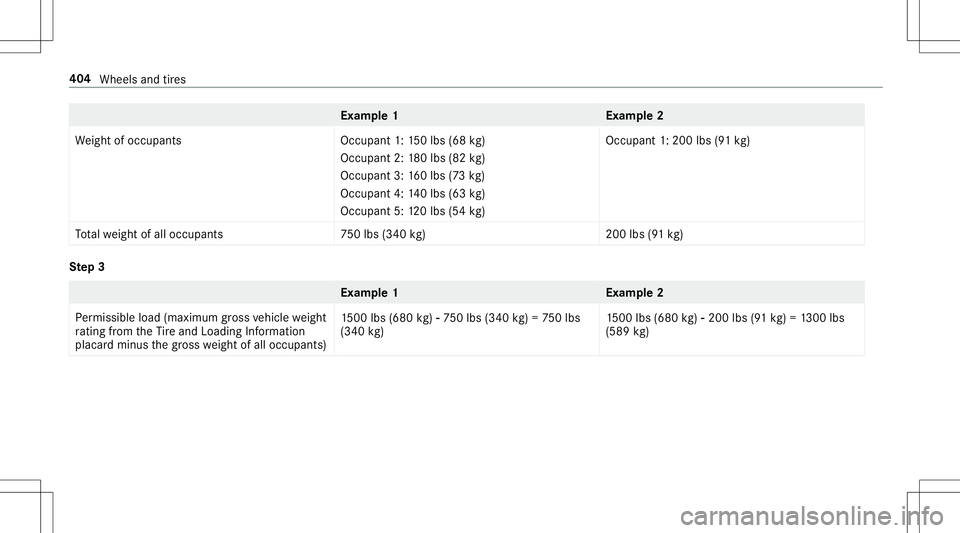
Ex
am ple 1E xamp le2
We ight ofocc upant sO ccupant1:150lbs (68 kg)
Occupant 2:180lbs (82 kg)
Occupant 3:160lbs (73 kg )
Occupant 4:140lbs (63 kg)
Occupant 5:120lbs (54kg ) Occupant
1:200 lbs(91 kg )
To talwe ight ofall occ upant s7 50lbs (340 kg)2 00lbs (91 kg ) Ste
p3 Ex
am ple 1E xamp le2
Pe rm issible load(maxim umgros sve hicle weight
ra ting from theTire and Loadi ngInfo rm atio n
placar dmin usthegr oss weight ofall occ upant s)15
00 lbs (680 kg)00F8 75 0lbs (340 kg)= 75 0lbs
(340 kg) 15
00 lbs (680 kg)00F8 200 lbs(91 kg )= 13 00 lbs
(589 kg) 40
4
Wheels andtires